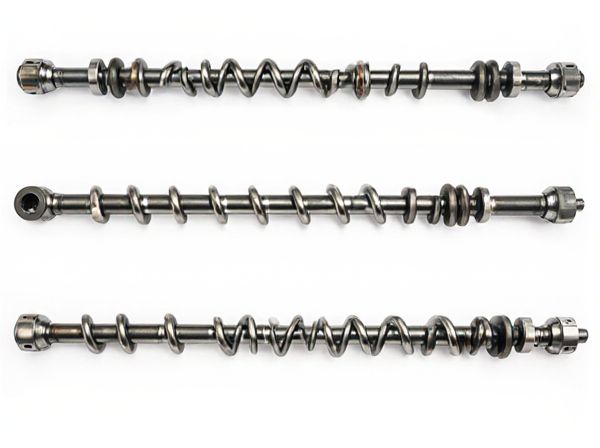
Photo illustration: Long Duration Camshaft vs Short Duration Camshaft
Long duration camshafts provide extended valve opening times, enhancing high RPM power and overall engine breathing efficiency. Short duration camshafts optimize valve timing for improved low-end torque, better idle quality, and fuel economy. Your choice depends on whether you prioritize peak horsepower or drivability and fuel efficiency.
Table of Comparison
| Feature | Long Duration Camshaft | Short Duration Camshaft |
|---|---|---|
| Valve Open Time | Extended valve open period | Brief valve open period |
| Engine Performance | Improves high RPM power and airflow | Enhances low to mid RPM torque and response |
| Fuel Efficiency | Reduced efficiency at low RPM | Better fuel economy in city driving |
| Idle Quality | Rougher idle, less stable | Smoother, more stable idle |
| Exhaust Emissions | Increased emissions due to valve overlap | Lower emissions with tighter timing |
| Best Use | Performance vehicles, racing applications | Daily drivers, street vehicles |
Introduction to Camshaft Duration
Camshaft duration refers to the length of time a camshaft keeps the valves open during each engine cycle, significantly affecting engine performance and efficiency. Long duration camshafts hold the valves open for a greater number of degrees of crankshaft rotation, enhancing high-RPM power and airflow. In contrast, short duration camshafts offer quicker valve opening and closing, improving low-end torque and throttle response.
Understanding Long Duration Camshafts
Long duration camshafts feature extended valve opening times, enhancing air and fuel intake for improved engine performance at higher RPMs. These camshafts increase overlap between intake and exhaust valves, contributing to greater volumetric efficiency and power output. Understanding long duration camshafts helps optimize engine tuning for racing or high-performance applications where sustained high-speed operation is critical.
Exploring Short Duration Camshafts
Short duration camshafts have a valve opening duration typically between 180 to 220 degrees, promoting better low-end torque and smoother engine idle compared to long duration cams. These camshafts enhance throttle response and fuel efficiency in daily driving by optimizing valve timing for slower engine speeds. Their design minimizes overlap, reducing exhaust emissions and making them ideal for street driving and mild performance applications.
Key Performance Differences
Long duration camshafts provide extended valve opening times, enhancing high RPM power and improving top-end engine performance by increasing air-fuel mixture flow. In contrast, short duration camshafts offer quicker valve opening and closing, delivering better low-end torque, improved idle quality, and enhanced drivability in everyday conditions. The choice between long and short duration cams impacts engine characteristics such as horsepower curves, throttle response, and fuel efficiency.
Effects on Engine Power and Torque
Long duration camshafts increase valve open time, enhancing high-RPM power by improving airflow and combustion efficiency, which boosts peak horsepower. Short duration camshafts favor low to mid-range RPM torque with quicker valve opening and closing, improving throttle response and engine drivability at lower speeds. Selecting between long and short duration cams depends on the desired power curve and performance characteristics for specific engine tuning goals.
Impact on Fuel Efficiency
Long duration camshafts extend valve opening times, improving engine breathing at high RPMs but often reducing fuel efficiency during low-speed or idle conditions due to increased overlap and pumping losses. Short duration camshafts enhance fuel efficiency by minimizing valve overlap, resulting in better combustion stability and lower fuel consumption in city driving and light-load scenarios. Choosing the appropriate camshaft duration balances performance demands with practical fuel economy, crucial for optimizing engine efficiency in various driving conditions.
Ideal Applications for Long Duration Camshafts
Long duration camshafts are ideal for high-RPM engines that require increased valve open time to improve airflow and maximize power output in racing or performance vehicles. These camshafts enhance top-end horsepower but may reduce low-end torque and idle quality, making them less suitable for daily driving or city use. They excel in applications such as track racing, drag racing, and high-performance street cars where sustained high engine speeds are common.
When to Choose Short Duration Camshafts
Short duration camshafts are ideal for engines designed to prioritize low-end torque and smoother idle characteristics, making them suitable for daily driving and street performance applications. They provide quicker valve opening and closing events, which enhances throttle response and fuel efficiency at lower RPMs. Choose short duration camshafts when the goal is improved engine drivability, reduced emissions, and better performance in the engine's low to mid RPM range.
Tuning Considerations and Compatibility
Long duration camshafts offer increased valve open time, enhancing high RPM power but may reduce low-end torque and drivability, requiring precise tuning of fuel injection and ignition timing. Short duration camshafts improve low-end torque and throttle response, making them compatible with stock or mild modifications, but limit peak power potential. Compatibility depends on engine configuration, intended use, and supporting components, with calibrated engine management systems critical for optimizing performance across varying cam profiles.
Final Thoughts: Choosing the Right Camshaft for Your Needs
Long duration camshafts offer improved high RPM performance and increased horsepower by extending valve open time, making them ideal for racing and high-performance engines. Short duration camshafts provide better low-end torque, smoother idle, and increased drivability, suited for street-driven vehicles and daily use. Selecting the right camshaft depends on your engine's intended use, desired powerband, and overall performance goals to ensure optimal results.
 caratoz.com
caratoz.com